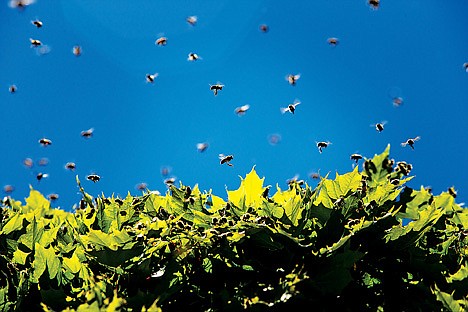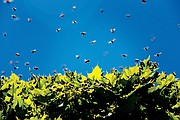Summertime stingers
COEUR d'ALENE - Backyard barbecue season may be a few months away, but it's not too early to start thinking about ways to deter those inevitable, buzzing summertime party crashers: wasps.
Entomology experts at the University of Idaho Extension in Moscow say it's too soon to tell if North Idaho residents are in for another summer population explosion of the winged stingers.
"It is important to know that spring weather largely determines if we will have any wasp problems or not in any given year," states a University of Idaho Extension publication for homeowners. "Cold, rainy weather during April and May reduces the likelihood that queens can build a nest and collect enough food to feed her immature offspring."
A short, warm spring - like the one experienced in North Idaho last year - increases the likelihood that growing nests will turn into successful colonies. Last August, hardware stores throughout the region had trouble keeping wasp sprays and traps in stock.
Thriving colonies of yellow jackets all start with one thing: a queen.
The University of Idaho Research Extension's "Homeowner Guide to Yellowjackets, Bald-Faced Hornets, and Paper Wasps," says that a single yellow jacket queen can lay tens of thousands of eggs during one season.
Most of these reproductive female wasps survive the North Idaho winters by hibernating outdoors, often under tree bark or in weedy areas on the ground.
It's not too early to set out some traps that may help keep some uninvited, flying, stinging guests away from decks and patios.
The university entomology experts say that with the warmer weather, the queens are now beginning to emerge from hibernation in Idaho. They generally begin buzzing around local yards and water sources in late March and April.
"Theoretically, one could eliminate yellowjacket nests in a single yard by trapping the initial overwintering queen during the spring," write the University of Idaho experts.
But trapping a queen in a yard won't keep away wasps from nests that survive farther away.
And it won't be easy to catch a buzzing matriarch. "Research shows that overwintering queens are notoriously unresponsive to traps," say the university entomology experts.
They will be building new nests, not re-using old ones.
Mike Terry, owner of GreenTec Lawn and Tree Service, offers another suggestion for homeowners looking for ways to try and keep flying stingers out of their yards this summer, without killing honeybees or any other insects.
"Honeybees are very desirable. We need the bees for pollination," said Terry, who has 27 years of experience in pest control application. "The paper wasps, they're awful."
Terry says that if homeowners reduce aphid populations in their yards, bees and wasps might stay away.
The key, he said, is to target certain species of oak, maple, linden and aspen trees that are prone to aphid activity.
Aphids feed on sap and juices from plants.
"They'll literally suck the core out of the foliage," Terry said.
And then the little suckers excrete it.
"That excretion is known as honeydew," Terry said. "That honeydew will attract bee type populations."
To keep the aphids away, most applicators use a soil drench, Terry said. An insecticide is placed around the base of a tree that's tempting to the tiny bugs, he said.
"That will give a taste that's undesirable to the aphids, and they'll go someplace else," Terry said. "If the aphids are not present, then the bees are not going to come."
If it's applied according to the label, it won't affect the honeybee population, Terry said.
For more wasp identification and management information, download a free copy of the University of Idaho publication "Homeowner Guide to Yellowjackets, Bald-Faced Hornets, and Paper Wasps" at http://www.cals.uidaho.edu/edComm/catalog.asp. Search "wasps."



